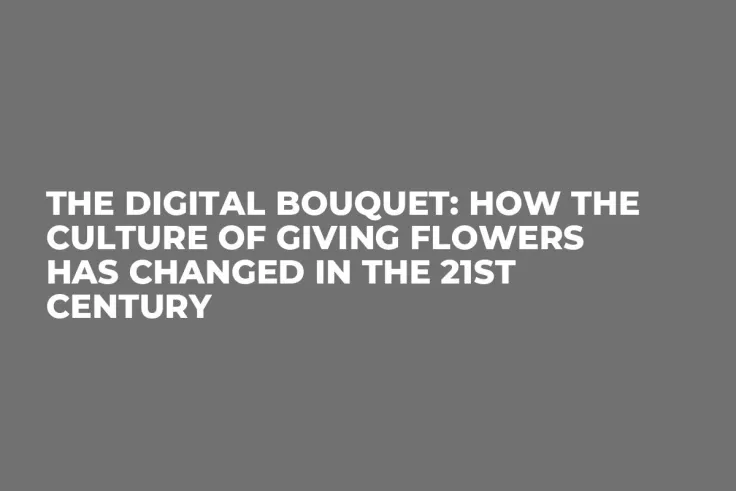
Disclaimer: The opinions expressed by our writers are their own and do not represent the views of U.Today. The financial and market information provided on U.Today is intended for informational purposes only. U.Today is not liable for any financial losses incurred while trading cryptocurrencies. Conduct your own research by contacting financial experts before making any investment decisions. We believe that all content is accurate as of the date of publication, but certain offers mentioned may no longer be available.
- From romance to care: Who gives flowersâand why
- Flowers and technology: New logistics, new meaning
- Social shifts: Gender, age, culture
- How the bouquet itself has changed
- The message matters more than the size
- Flowers as a form of mindfulness
- Sustainability: The new frontier
- In summary: Flowers remainâbut their meaning has grown
When we hear "giving flowers," we often picture a traditional scene: a man hands a bouquet to a woman, a student presents flowers to a teacher, or a grandchild brings them to a grandmother. But the 21st century has transformed more than just technology—it has also reshaped social gestures. Flowers remain, but the meanings, occasions, and delivery methods have evolved. Today, a bouquet isn’t just about romance; it certainly isn’t just for women.
Flowers have become a digital language of care and connection in a world where you can order flowers to Miami, London, or Tokyo in just a few clicks from anywhere globally. They no longer require a special occasion, aren’t restricted by gender or age, and can even be gifted to oneself, as a gesture of self-compassion. So what does the new etiquette of flower-giving look like?
From romance to care: Who gives flowers—and why
While flowers were once associated primarily with courtship, celebrations, or formal occasions, today they’re part of everyday life. Young people now gift flowers to friends, colleagues, parents, and even themselves, not out of obligation, but as a heartfelt act.
A bouquet might say: “I know things are tough,” “You did great,” “I’m sorry,” “Thank you,” or “You matter.” Buying flowers for your home is no longer considered indulgent—it’s a way to elevate your space, shift your mood, and remind yourself that beauty and care belong in the everyday.
Flowers and technology: New logistics, new meaning
Flower-giving used to be an in-person experience: you’d visit a florist, select a bouquet, and hand it over yourself. Now, with delivery services, you can choose, pay, and send a bouquet with a message in minutes, without ever leaving your home. This has created new formats:
- Surprise flowers “just because” — delivered without a reason, to brighten someone’s day
- Anonymous bouquets — a low-pressure way to express affection or admiration
- “Build-your-own bouquet” tools — let users choose flowers by mood, personality, or even zodiac sign.
- Flower subscriptions — like coffee or movies: weekly deliveries to homes or offices
In short, flowers have moved beyond tradition. They’ve become a lifestyle touchpoint.
Social shifts: Gender, age, culture
In the 21st century, flowers are no longer bound to the “man gives, woman receives” rule. More men are receiving (and enjoying) bouquets. More women are giving flowers to friends and coworkers, not out of politeness but sincerity. Young people send flowers to anyone, regardless of gender, if the moment feels right.
New kinds of occasions have also emerged:
- finishing therapy,
- delivering a first solo presentation,
- moving into a new apartment,
- quitting a toxic job,
- celebrating the anniversary of self-love.
And no—it’s not ironic. It’s a new form of honesty. A bouquet can be emotional literacy, recognizing your or someone else's growth, transition, or resilience.
How the bouquet itself has changed
Gone are the stiff, formal rose pyramids. In their place: free-flowing arrangements, wildflower aesthetics, asymmetry, and natural textures. Today’s bouquets express feeling, rhythm, and breath, not perfection.
Popular trends now include:
- seasonal flower mixes,
- monobouquets with unusual varieties (like mimosa, hydrangea, or lavender),
- kraft paper or unwrapped bouquets,
- dried flower arrangements,
- eco-conscious designs with no plastic or foam blocks.
Color schemes have also softened—less contrast, more nuance, with earthy, muted tones.
The message matters more than the size
Today’s bouquets are often accompanied by handwritten notes or digital messages; this is where the real magic happens. Instead of formal greetings, people now write:
- “I hope you find a moment of peace today.”
- “You are the flower. Just a reminder.”
- “If I could wrap my support in something beautiful, it would look like this.”
Of course, flowers alone are still meaningful. But adding a personal note deepens the emotional impact.
Flowers as a form of mindfulness
Buying flowers isn't always about others. More and more people—especially women—are buying flowers for themselves. And it’s not out of loneliness or vanity. It’s a form of self-respect. A way of saying, “I deserve beauty on a regular Tuesday.”
Giving yourself flowers is an act of friendship with yourself. It’s a ritual of acknowledgement—of your fatigue, progress, and hopes. It’s a declaration: I’m worth this. And it comes with rituals—trimming stems, changing water, watching each bloom evolve.
Sustainability: The new frontier
Modern consumers are increasingly conscious of where flowers come from, their packaging, and their environmental impact. The floral industry is adapting:
- sourcing from local farms,
- using recyclable or compostable materials,
- ditching floral foam,
- creating long-lasting arrangements.
Sustainability is becoming part of the bouquet’s message, making each gesture beautiful and responsible.
In summary: Flowers remain—but their meaning has grown
In the 21st century, flower-giving is more open, expressive, and free than ever. The old rules—“who can give,” “what’s appropriate,” “what must be included”—are fading. In their place: spontaneity, authenticity, and diversity.
Flowers today are not a symbol of obligation or formality. They’re a way to say, “I’m thinking of you,” “I see you,” “I care.” They’ve become part of communicating, connecting, and caring in an increasingly digital, fast-paced world.
And in that lies their timeless power.
 Dan Burgin
Dan Burgin Vladislav Sopov
Vladislav Sopov U.Today Editorial Team
U.Today Editorial Team